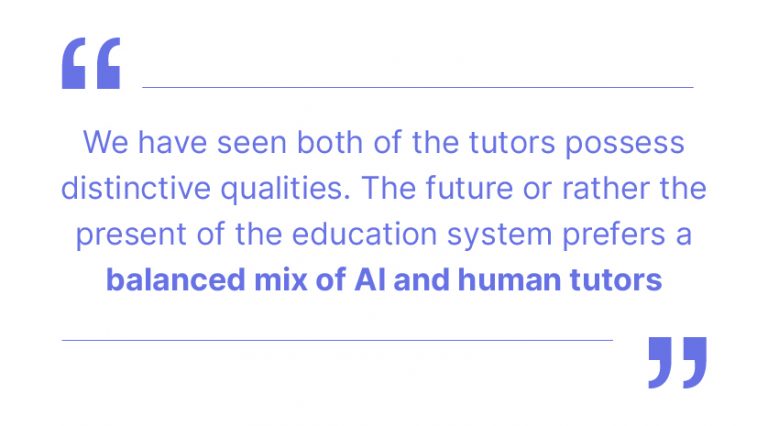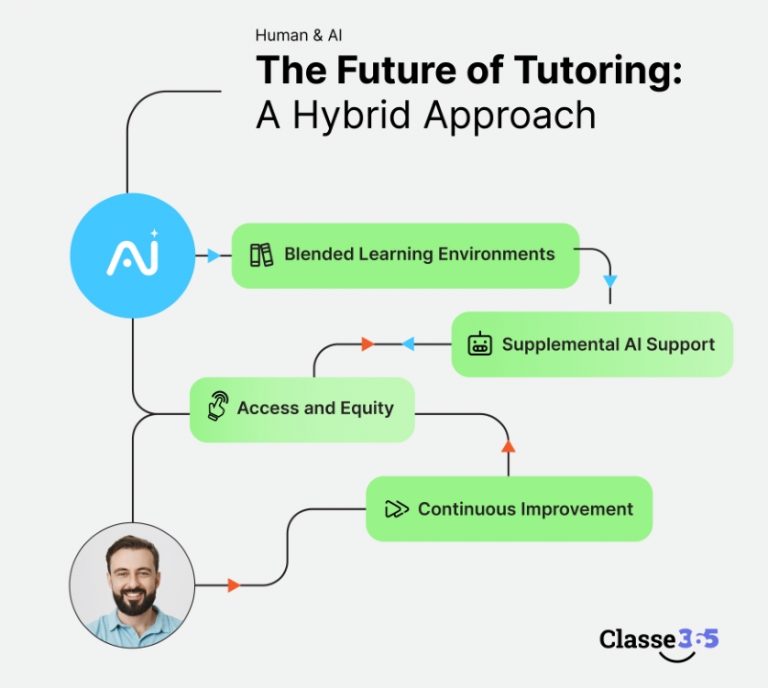American writer and biochemist, Issac Asimov predicted long back (in 1951) how the future of tutoring will be. In his science-fiction “The Fun They Had”, he introduced a computer as a teacher that resembles AI tutors of the present day. The burning question of our time is whether AI will replace human teachers. Before addressing that argument, we must understand what unique features AI tutoring is bringing to the table. Let us delve deeper:
Offerings of AI Tutoring System
Frederick M. Hess in his book, The Great School Rethink, has explained that tutoring is mostly about conveying content and explaining concepts. Both of the aspects are quantitative and informative. According to researchers, AI tutors are prepared to assist human beings with information and simple explanations. Therefore, when it comes to AI tutoring, we are offered with:
Prompt Feedback:
Technology was made to move the human race faster. AI tutor is no exception. Students do not have to wait for feedback on their assignments. AI can evaluate responses and provide constructive feedback in seconds. As the evaluation process is based on some fixed parameters, the students get feedback only on those areas. Therefore, AI feedback is more useful in STEM because humanities demand critical analysis.
Customized Features:
AI algorithms analyze student performance data, learning preferences, and historical interactions to create personalized learning paths.
Each student receives a customized curriculum based on their strengths, weaknesses, and learning pace. For example:
The AI system might provide additional practice problems or recommend relevant video tutorials if a student struggles with algebraic equations.
If another student excels in geometry, the system might offer more challenging problems or explore advanced concepts.
Flexibility
One of the primary reasons behind this AI vs human tutoring argument is the flexibility of AI tutors. While traditional classrooms face limitations in terms of class size, teacher availability, and physical space, AI tutors can handle an unlimited number of students simultaneously.
Though this feature bridges the gaps like geographical boundaries and time zones, the intricacy of the subject matter is often untouched.
Where Human Tutors Differ from AI Tutors
In his book, The Great School Rethink Frederick M. Hess also mentioned that human beings are not mere tutors, they are mentors. Idolizing and taking inspiration from their seniors are invaluable parts of a child’s upbringing. An AI tutor has yet to pose as a role model before children. Therefore, to define human tutors, we must touch upon the following areas:
Emotional Intellect
A major portion of human intellect is overpowered by emotional intellect. If you closely observe the movements in history and literature, you will notice that the evolution of human intellect is closely connected with, or sometimes, dominated by nature and emotion.
Here comes the reference of famous anthropologist Margaret Mead who said the first sign of civilization in an ancient culture is a femur that had been broken and then healed. She theorized that in the animal kingdom, if you break your leg, you die because you cannot run from danger, hunt, and survive. But, a healed thigh bone is a sign that someone has taken time to care for the injured. So, emotion lies at the root of human civilization. Thus, human intellect is majorly driven by emotions.
Communication and Face-to-Face Learning
The biggest challenge during COVID-19 was online education. A sheer dependence on technology and no face-to-face interaction created a severe lack of attention span. According to NIH (National Institute of Health), more than 1.5 million students from across the United States exhibited worse performance in mathematics and reading scores compared with the previous academic year.
A noticeable decrease in children’s cognitive skills was due to the lack of real-time communication with the teacher.
Further Learning Opportunities
While an AI tutor’s guidance is often limited to what it is asked or instructed to, human tutors inspire students to learn further. A reference part at the end of every book invites students to delve deeper into the topics they have been introduced to. Features like these distinguish a book by a human author from technical notes by an AI guide.
Now that we have explored every possibility and unique approach of both tutors, it’s time to discuss the future of tutoring. The biggest question dangles here is whether it should be: AI vs Human Tutor or AI and Human Tutor.
We have seen both of the tutors possess distinctive qualities. The future or rather the present of the education system prefers a balanced mix of AI and human tutors.

The Future of Tutoring: A Hybrid Approach
The future of tutoring likely lies in a hybrid approach that leverages the strengths of both human and AI tutors. This model can provide a more comprehensive and effective learning experience by combining the best attributes of both.

Blended Learning Environments: Schools and educational institutions can integrate AI tutors to handle routine tasks, assessments, and personalized practice while human tutors focus on higher-order thinking, emotional support, and complex problem-solving. An education management system like Classe365 makes it easier for teachers where you can design, schedule, and assign tasks to the students without any hassle.
Supplemental AI Support: Human tutors can use AI tools to enhance their teaching. For example, AI can provide data-driven insights into student progress, enabling tutors to tailor the instruction more effectively.
Access and Equity: AI tutors can democratize education by providing affordable and scalable tutoring solutions to underserved communities. Human tutors can then be allocated to students who need the most support, ensuring equitable access to quality education.
Continuous Improvement: AI technologies can continuously learn and improve based on student interactions. This iterative process can lead to increasingly sophisticated and effective AI tutors.
The future of tutoring is not a matter of either human or AI tutors, but rather a collaborative approach integrating the strengths of both to create a more effective, comprehensive, and accessible educational experience.
